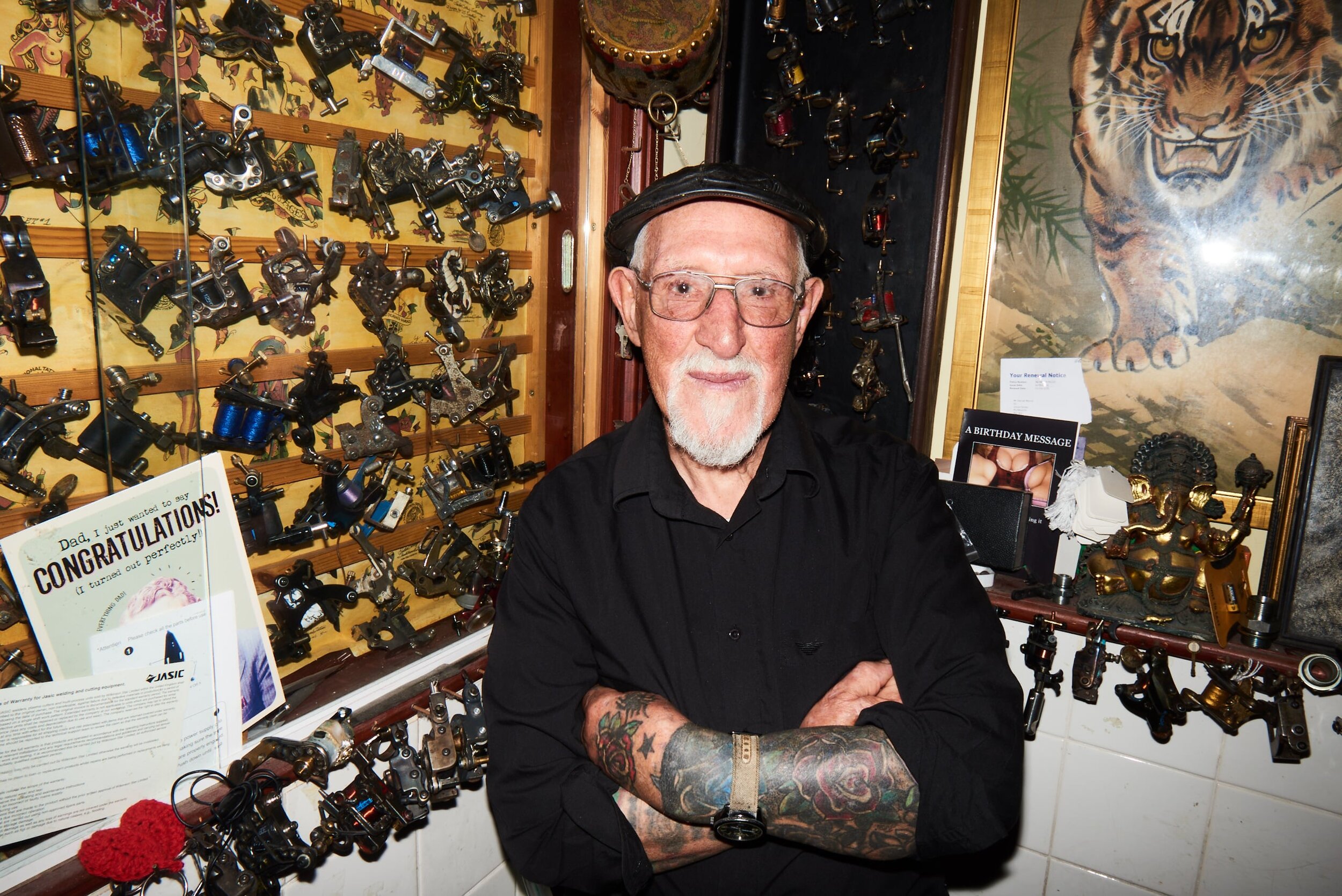Doc Price
Doc Price, The UK’s oldest tattooist will be inking his last ever tattoo at this year’s London Tattoo Convention. Jane Tarrant met the legendary Doc Price at his old school tattoo shop in Plymouth to talk about his remarkable life.
Darrell “Doc” Price is 86. He mightn’t be the world’s oldest tattooist (there is talk of a 101-year-old woman in the Burmese mountains). But he reckons he’s definitely the oldest in Europe. And according to which report you read, he’s inked, freehand, something in the vicinity of between 28 and 40 acres of skin
During that time, he’s witnessed the art form rise from the underground to the mainstream: one in five people now have a tattoo. Even David Dimbleby has a tattoo – a six-legged scorpion on his right shoulder, received when he was a youthful 75.
Doc reckons “social media has a lot to do with it”, along with the influence of friends and partners: “Young people now need to impress other young people.” But he also cites the quality of modern designs. “They’re incredibly beautiful compared to what it was in my day, when you had just seven needle heads and a bit of colouring in a dish.” Back then, you could only choose between red, green, yellow, primary colours. “When I saw my first ever blue ink tattoo, I was jumping up and down with tears.”
He first became fascinated with the art while growing up in a little country town on the Welsh marshes called Hereford. He’d been mesmerised by a blue butterfly design on the back of a former sailor’s hand, and for the young Doc, the idea that something could live forever on someone’s body was truly magical.
When he was 13, he got one of his own, from an “ancient guy” called Billy Knight in Cardiff. “I had to go and convince my mother, because I come from a family where nobody got tattooed” he says. His tattoo, said, simply, ‘Mother.’ His mum loved it, although his father wasn’t best pleased. Why couldn’t it have said ‘Dad’? “So I had to go back the next week. It said ‘Dad.’ I didn’t realise how painful it was going to be, because in those days they didn’t clean their needles properly. It was very, very, primitive.”
He inked his first tattoo, a French Legion cross, around the same time (“You could get away with it because you went to work at 14 in those days”). But he had to work it out on his own. “In my generation, there were no apprenticeships. You were either born into a tattoo family or outside. And if you were born outside you had to teach yourself.”
A few years later, he bought his first brass tattoo machine for £7.10, and set up shop in Barry Island, South Wales, having initially practiced on his workmates at building sites. He’d specialise in motifs such as roses, skulls, swallows and panthers, and his first clients were mainly sailors from the Royal Navy and prostitutes (“pavement princesses”).
“We’d use the same, unsterilized needle all week, and the same head chrome. By today’s standard that was totally crazy. And yet… when soldiers served in the British Army in India, they too would be tattooed by tattooists who never cleaned their stuff and tattooed with whatever was use to tattoo before.”
WORLD TOUR
Life hasn’t always been plain sailing: in 1966 his own young family lost all their personal belongings (and Doc’s tattooing equipment) when the ship carrying their luggage en route to a new life in South Africa sank in the harbour. “I had bought my wife a silver teapot, one which was really old… I think that was the only thing for which she wept!”
He has studied Japanese tattooing techniques in Japan, with a man called Caso Orgori. “He was remarkable and I think he’s still alive, the old chap. And the martial arts flowed from that.” Doc thinks it was probably his personality that drew him to martial arts, “because tattooing is a pretty tough game. A lot of the people coming in are aggressive.” In 1969 he’d represent Australia in the World Kendo Championships – and many years later, aged 75, come first in his age group in the Japanese Kendo World Championships.
He eventually settled in Plymouth with his wife, son and daughter, and works out of his studio at 92 Union Street, as immortalised in a Beryl Cook painting, listening to country music while he works (he’s a big Glen Campbell fan). He doesn’t know exactly how many tattoos he has – “I’ve never counted them” – but among them are ‘autographs’ from long gone well-known tattooists (“This is Les Skues… this is Cash Cooper from Piccadilly Circus...”).
It’s a real family business: his late wife inked too, and furnished her husband with a Welsh dragon; while his son Bill works alongside him. “Everyone else was getting tattoos by their dad when they were 16 and 17,” says Bill. “I had to bloody wait until I was 18 to get mine!” What advice would Doc pass on to Bill? “Treat every day as something special. This is all there is.”
Celebrity clients have included the motorcyclist Eddie Kidd, who later had his tattoos removed (“I was shocked when I found out,” says Bill, “I thought, ‘you’re a traitor to your true self’”) and the swimmer Sharron Davies, who Bill decorated with “a little baby elephant squirting water on her arse cheek... I took 15 minutes etching it out and 40 minutes making sure it was done properly”.
Pain threshold can vary, he says, depending on the individual. “On a scale of one to 10, when it starts off it’s the shock of it, so that’s a six or seven. After a while it goes down to like a two or something.” He can use a numbing cream, “but it gets in the hair”. A back tattoo might take between a year or two years – “the tolerance is three to four hours, and then the body starts to break down because it’s seriously uncomfortable.”
“Obsessive” is the word he uses for some of his long-term, elderly customers, whose tattoos will need ‘topping up’ depending on their lifestyle: people’s skin varies a lot, he says. Office workers will have longer lasting designs than those who work outdoors, where sunrays, gamma rays and ultraviolet rays will take their toll.
He thinks very few people think about the implications of a tattoo’s longevity: “I’ve never worked out the psychology of why somebody would want to get a tattoo. It’s a peculiar and human thing, isn’t it.” And in time, tattoos become “lovely memories… it’s your human history, your personal history of when you had it done.”
REQUEST SHOW
Religious iconogaphy is especially popular among young people. As Bill quips: “It means you go to church at least once every lifetime!” The oddest request Doc has ever had was to tattoo a man’s last will and testament on his back. “I didn’t tell him about the spelling mistakes either! I think he just wanted to do it because he had a funny sense of humour.”
No request is too extreme, though: “It’s not a problem, because to me making a tattoo is as natural as breathing the living air, but for the customer it’s a big experience.” That said, he’ll usually only do facial tattoos “if we’ve had a long-term relation with them”. He’s also made it a point of principle not to tattoo anybody who’s drunk. “If you start, you regret it instantly because they’re sick over you.”
One of his most memorable encounters was the British intelligence officer who wanted a scar tattooed above his eye, because he wanted to blend in with the IRA. He called the police after glimpsing a handgun “the size of a chair” in his immaculate briefcase – turns out he was ex-forces, but was suffering from delusions.
While one of the most unfortunate tattoos he’s ever seen belonged to the tourist who’d asked for his girlfriend’s name rendered on the back of his neck in ‘Chinese characters’, while abroad. As Price related to the Plymouth Herald, “My girlfriend, who is from Thailand, wasn't so sure. So we took him to see a friend of ours who is Chinese and we asked her, 'what does this say here? She looked at it and said, 'why have you got a tattoo of Windows 7 on your neck? We couldn't stop laughing.”
And now, after 63 years, Britain’s most venerable skin artist is finally laying down his needle. Well, kind of. While the illustration he’ll deliver at the London Tattoo Convention (“an old style traditional tattoo that’s familiar to me”) is to be his ‘retirement’ work, any carried out after this will be repair only – and he’s performed plenty of those too, over the past seven decades.
Naturally, some of those repair jobs will be the deletion, or rather transforming, of ex-partners’ names. “We’ve always considered ourselves to be in the love business,” says Doc. “We’re either putting the new love on or covering one up. There was one type of name, style or writing that we used, and when we covered it up it looked like a little reef and I’d say, ‘There you are, you’ve just buried your ex!’”
Words by Ali Catterall for The London Tattoo Convention 2019 Guide
Photo by David Titlow








